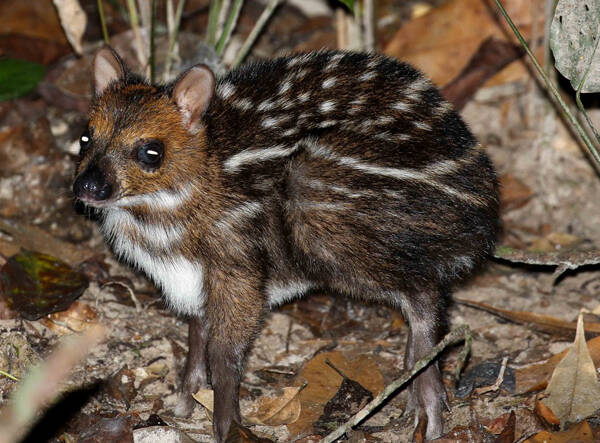Hyemoschus aquaticus
IUCN
LCBasic Information
Scientific classification
- name:Hyemoschus aquaticus
- Scientific Name:Hyemoschus aquaticus, Water Chevrotain,Chevrotain Aquatique, Antilope Amizclero Enano de Agua, Hirschferkel
- Outline:Ungulata
- Family:Artiodactylus Tragopanidae Water deer
Vital signs
- length:45-85cm
- Weight:7-15kg
- lifetime:8-13years
Feature
The coat has horizontal white stripes and rows of white spots, and a series of inverted white "V" shapes on the throat.
Distribution and Habitat
The water mouse deer is endemic to the tropical regions of the African continent. Its distribution is mainly limited to coastal areas. It is found in Cameroon, Central African Republic, Democratic Republic of the Congo, Congo (Brazzaville), Cote d'Ivoire, Equatorial Guinea, Gabon, Ghana, Guinea, Liberia, Nigeria, Sierra Leone and Togo.
Found in rainforests and scrublands, rarely more than 250 meters from the water. At night, it can be observed in exposed open spaces and open riverbanks.
Appearance
The water chevrotain is a small animal similar to a species in the family Cervidae. The species is larger than its Asian cousins, and is similar in size to a rabbit. It has a body length of 45–85 cm, a tail length of 7.5–17 cm, and weighs 7–15 kg. Females tend to be larger than males, with males averaging only 9.7 kg, while females average 12 kg. The water chevrotain has large eyes, slit-like nostrils, and medium-sized ears. It has a small, pointed head and a sturdy body with long, slender legs. The hindquarters are larger than the forequarters, and the back of the body is wedge-shaped and slightly higher relative to the rest of the body when the head is low to the ground. Neither sex has horns, but males of the species have well-developed small tusks that extend below the animal's lips.
The brown fur has horizontal white stripes and rows of white spots, which help with mimicry and camouflage in the forest. There are white stripes on the head and neck, and a series of inverted
Details
Water Chevrotain [shuǐ xī lù] (scientific name: Hyemoschus aquaticus) English: Water Chevrotain, French: Chevrotain Aquatique, Spanish: Antilope Amizclero Enano de Agua, German: Hirschferkel, no subspecies, is the largest member of the family Hyemoschus.

Water deer females are sedentary, occupying stable home ranges that rarely overlap with the home ranges of other females. Female home territories are smaller than males, measuring about 13-14 hectares. Males are solitary and tend to move around more, occupying temporary home ranges of 20-30 hectares. This range often overlaps with the home ranges of several females. Males occupy a home range for a maximum of one year, after which they are replaced by another male. Densities range from 7.7 to 28 individuals per square kilometer, but water deer rarely come into contact with each other. Perhaps because of this, young animals rarely engage in play activities.
Unlike other species in the genus, water deer are active only at night, foraging in open areas at night and returning to rest under the cover of dense ground vegetation during the day. The first response of water deer to the presence of a predator is to stand still; if the threat continues to approach, they will retreat into the water, where the species can dive below the surface and become almost completely submerged. Although the water is used as a refuge from predators, they cannot swim for long periods of time. Noises made by water deer include screams, alarm calls, and high-pitched chatter.
Water deer are solitary animals. Females are much more active than males. Aggression observed in this species is rare, which some researchers believe indicates a lack of social hierarchy. Males occasionally engage in brief fights, where males bite their opponents with their sharp canines. Injuries sustained in these fights are the most likely reason for the general avoidance of conspecifics observed in these water deer.

Water deer are primarily herbivorous, feeding on leaves, stems, fruits, and buds of trees and shrubs. They occasionally eat insects, crustaceans, and even small mammals. Like many herbivores, water deer have various adaptations to facilitate efficient digestion of their low-nutrient diet. They are considered true ruminants, with a 4-chambered ruminant stomach.
Water deer breed year-round, but peak births occur in January and July or August. When a female enters estrus, the male will follow her movements and make sounds to court her. The male's calls stop the female from moving, at which point the male will lick the female's genital area. This pattern repeats for a while. The male mates by pressing his body against the female. The gestation period is 6-9 months, and females give birth to one cub per year. The cubs mature early and are able to stand within an hour of birth. Females hide their cubs in the grass, and they spend most of their time apart from their cubs, going out to move and forage alone, meeting only to feed them. The lactation period lasts 3-6 months, and when they reach sexual maturity, the cubs leave their mother's home range. Females reach sexual maturity in about 17 months; males between 5-27 months. Lifespan is usually 8 years, with a maximum of 13 years.
The population of the water deer is generally declining. In the Ituri Forest, the density was recorded in 2013 at 1.5-5.0 per square kilometer, and in Gabon at 28 per square kilometer. As of 2016, the total number of water deer was estimated to be about 280,000 animals. Despite the decline due to bushmeat hunting and habitat loss, it is not considered close to reaching any threshold for threatened status and is considered to be of Least Concern. However, if the trend of habitat loss continues, the status of the water deer may decline further in the coming decades and may need to be reassessed.
Listed in the IUCN Red List of Threatened Species (IUCN) 2016 ver3.1 - Least Concern (LC).
Protect wild animals and stop eating game.
Maintaining ecological balance is everyone's responsibility!








